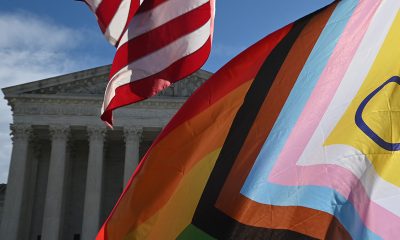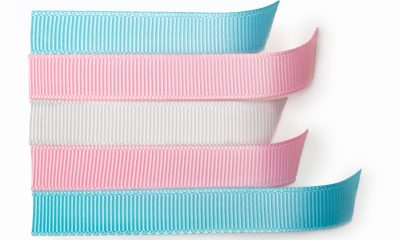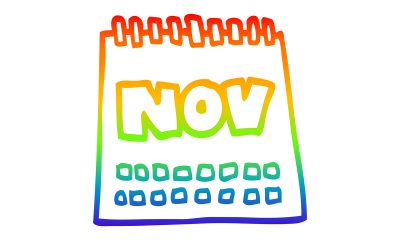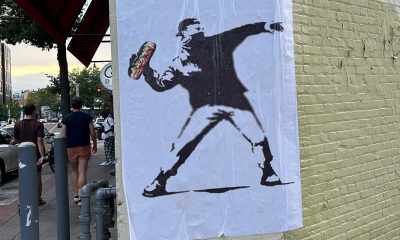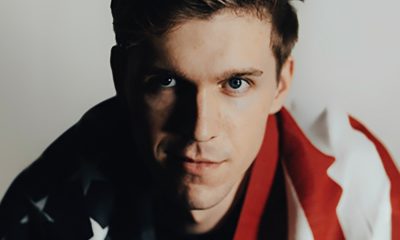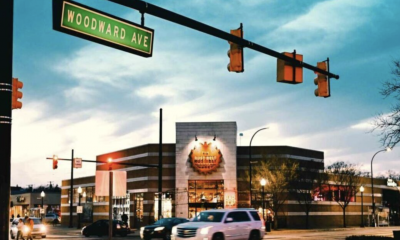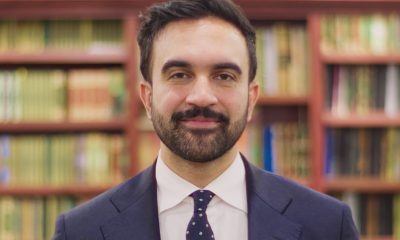District of Columbia
Nearly 100 attend vigil for slain trans woman A’Nee Roberson
D.C. police release video, photos of ‘person of interest’ linked to murder
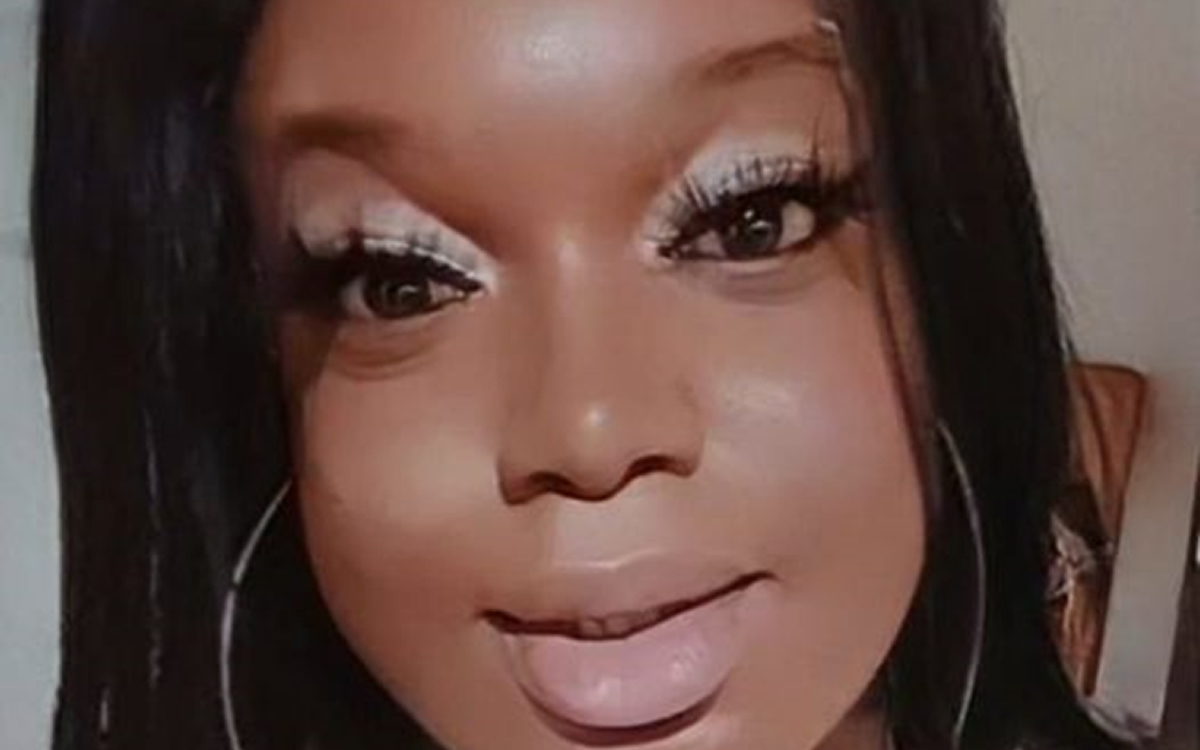
Close to 100 people turned out late Wednesday afternoon, Oct. 25, for a candlelight vigil on the 900 block of U Street, N.W. in honor of local transgender woman A’Nee Roberson, 30.
D.C. police said Roberson was fatally struck by a car on U Street in that location on Oct. 14 while fleeing from a yet unidentified man who assaulted her and who police say committed second-degree murder by causing her to be hit by a car.
The vigil was organized by Iya Dammons, executive director of the transgender and LGBTQ services organization DC Safe Haven, and Earline Budd, founder of the local group Empowering the Transgender Community (ETC), with support from many local activists, the two women said.
It took place on the sidewalk in front of Nellie’s Sports Bar at 900 U St., N.W., steps away from where police say witnesses saw Roberson being assaulted and chased into the street about 4:20 a.m. on Saturday, Oct. 14, where she was hit by an oncoming car.
Police have not said whether they know why Roberson was at that location more than an hour after Nellie’s and other bars and nightclubs in that location had closed for the night. The driver of the car stopped at the scene and cooperated with police investigators, police have said.
More than 20 people spoke at the vigil, including Roberson’s father and brother, who were accompanied by other family members, all of whom said they loved A’Nee for who she was.
The vigil also took place one day after D.C. police released a video and photos taken from the video of a male “person of interest” who police are seeking help from the public in identifying. Police said the video was obtained from a nearby security camera.

Among those attending the vigil were members of the police LGBT Liaison Unit, who handed out flyers announcing police are offering a reward of up to $25,000 to anyone who provides information leading to the arrest and conviction of the person or persons responsible for Roberson’s murder.
“Today we stand in solidarity as one community,” Dammons told the gathering. She called on the crowd to yell out the name “A’Nee” loudly and repeatedly in honor of Roberson’s life and memory.
“In the face of adversity, we rise, we shine, conquer,” Dammons said. “We are Black, we are trans, we are queer. We are willing and we are more than what the world sees us, more than the world knows us.”
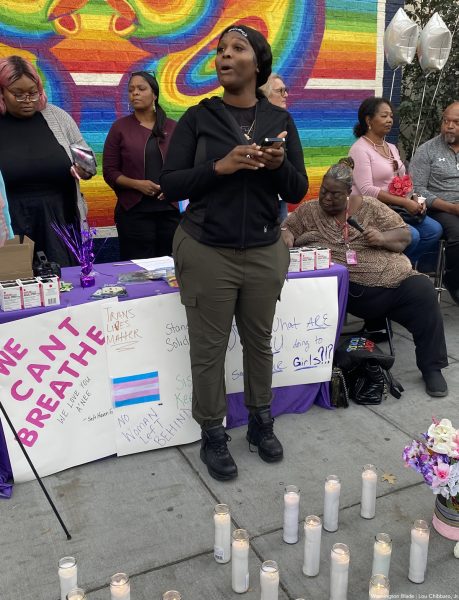
D.C. Councilmember Zachary Parker (D-Ward 5), the Council’s only gay member, told the crowd he and his fellow Council members express their love and support for Roberson’s family and many friends who are mourning her loss.
“Her death is not in vain,” Parker said. “We are going to keep her spirit alive and bring her murderer to justice,” said Parker, who also asked the crowd to yell out the name A’Nee several times.
Gay D.C. Advisory Neighborhood Commissioner Vincent Slatt, who is a member of the ANC LGBTQ Rainbow Caucus, told the gathering the Rainbow Caucus was advocating for the city to address in a more aggressive way violence targeting the trans community and the LGBTQ community. Also expressing support at the vigil for improved efforts to address violence targeting the trans community was June Crenshaw, executive director of the Wanda Alston Foundation, which provides housing services for homeless LGBTQ youth.
Also speaking at the vigil were at least four former employees or clients of the now closed Casa Ruby DC LGBTQ community services center, who said A’Nee Roberson was affiliated with Casa Ruby and acted as a loving and supportive mentor to them.
Gary Roberson, A’Nee Roberson’s father, thanked participants for turning out at a vigil he said demonstrated the strong support and love his daughter had from the community.
“Me, as her dad, had no choice but to support her,” Gary Roberson said after telling how he, his wife, and other children embraced and supported A’Nee after she came out to them as trans at the age of 13.
“From this day forward, I am part of the LGBTQ community,” he said. “You have my support. Thank you so much for coming out today.”
Also speaking at the vigil was Japer Bowles, director of the Mayor’s Office of LGBTQ Affairs.
“We are all sick and tired of coming to these things to see justice done,” he told the gathering. “We need to see justice done. We are doing what we can,” he said in referring to the city government’s efforts to end violence targeting the trans and LGBTQ community.
Nellie’s, which is an LGBTQ establishment, placed a large chalkboard sign on the sidewalk next to a table where the speakers at the vigil stood. A handwritten message on the chalkboard said, “The Hearts and Mind of The Nellie’s Family are with The Family of A’Nee Roberson.”
The police video and photos of the person of interest in the A’Nee murder is below:
District of Columbia
‘Sandwich guy’ not guilty in assault case
Sean Charles Dunn faced misdemeanor charge
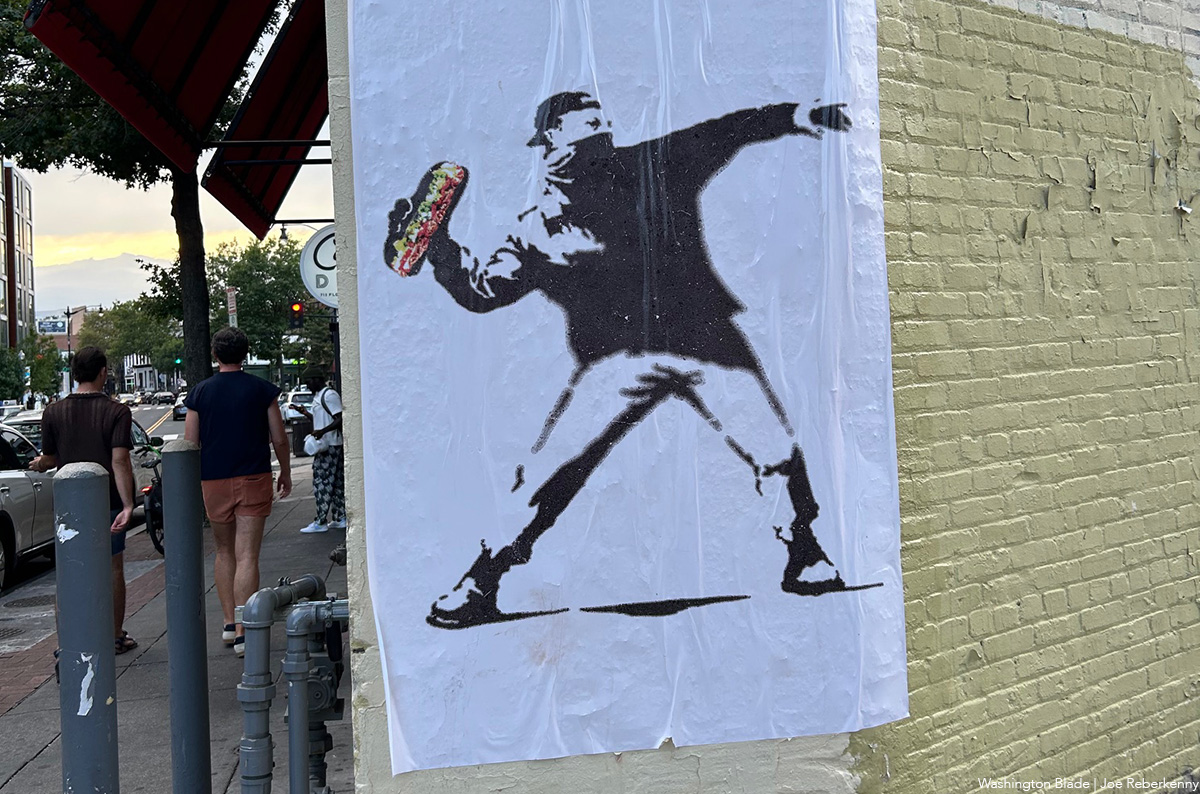
A jury with the U.S. District Court for the District of Columbia on Thursday, Nov. 6, found D.C. resident Sean Charles Dunn not guilty of assault for tossing a hero sandwich into the chest of a U.S. Customs and Border Protection agent at the intersection of 14th and U streets, N.W. at around 11 p.m. on Aug. 10.
Dunn’s attorneys hailed the verdict as a gesture of support for Dunn’s contention that his action, which was captured on video that went viral on social media, was an exercise of his First Amendment right to protest the federal border agent’s participating in President Donald Trump’s deployment of federal troops on D.C. streets.
Friends of Dunn have said that shortly before the sandwich tossing incident took place Dunn had been at the nearby gay nightclub Bunker, which was hosting a Latin dance party called Tropicoqueta. Sabrina Shroff, one of three attorneys representing Dunn at the trial, said during the trial after Dunn left the nightclub he went to the submarine sandwich shop on 14th Street at the corner of U Street, where he saw the border patrol agent and other law enforcement officers standing in front of the shop.
Shroff and others who know Dunn have said he was fearful that the border agent outside the sub shop and immigrant agents might raid the Bunker Latin night event. Bunker’s entrance is on U Street just around the corner from the sub shop where the federal agents were standing.
“I am so happy that justice prevails in spite of everything happening,“ Dunn told reporters outside the courthouse after the verdict while joined by his attorneys. “And that night I believed that I was protecting the rights of immigrants,” he said.
“And let us not forget that the great seal of the United States says, E Pluribus Unum,” he continued. “That means from many, one. Every life matters no matter where you came from, no matter how you got here, no matter how you identify, you have the right to live a life that is free.”
The verdict followed a two-day trial with testimony by just two witnesses, U.S. Customs and Border Protection agent Gregory Lairmore, who identified Dunn as the person who threw the sandwich at his chest, and Metro Transit Police Detective Daina Henry, who told the jury she witnessed Dunn toss the sandwich at Lairmore while shouting obscenities.
Shroff told the jury Dunn was exercising his First Amendment right to protest and that the tossing of the sandwich at Lairmore, who was wearing a bulletproof vest, did not constitute an assault under the federal assault law to which Dunn was charged, among other things, because the federal agent was not injured.
Prosecutors with the Office of the U.S. Attorney for D.C. initially attempted to obtain a grand jury indictment of Dunn on a felony assault charge. But the grand jury refused to hand down an indictment on that charge, court records show. Prosecutors then filed a criminal complaint against Dunn on the misdemeanor charge of assaulting, resisting, or impeding certain officers of the United States.
“Dunn stood within inches of Victim 1,” the criminal complaint states, “pointing his finger in Victim 1’s face, and yelled, Fuck you! You fucking fascists! Why are you here? I don’t want you in my city!”
The complaint continues by stating, “An Instagram video recorded by an observer captured the incident. The video depicts Dunn screaming at V-1 within inches of his face for several seconds before winding his arm back and forcefully throwing a sub-style sandwich at V-1.
Prosecutors repeatedly played the video of the incident for the jurors on video screens in the courtroom.
Dunn, who chose not to testify at his trial, and his attorneys have not disputed the obvious evidence that Dunn threw the sandwich that hit Lairmore in the chest. Lead defense attorney Shroff and co-defense attorneys Julia Gatto and Nicholas Silverman argued that Dunn’s action did not constitute an assault under the legal definition of common law assault in the federal assault statute.
Assistant U.S. Attorney Michael DiLorenzo, the lead prosecutor in the case, strongly disputed that claim, citing various provisions in the law and appeals court rulings that he claimed upheld his and the government’s contention that an “assault” can take place even if a victim is not injured as well as if there was no physical contact between the victim and an alleged assailant, only a threat of physical contact and injury.
The dispute over the intricacies of the assault law and whether Dunn’s action reached the level of an assault under the law dominated the two-day trial, with U.S. District Court Judge Carl J. Nichols, who presided over the trial, weighing in with his own interpretation of the assault statute. Among other things, he said it would be up to the jury to decide whether or not Dunn committed an assault.
Court observers have said in cases like this, a jury could have issued a so-called “nullification” verdict in which they acquit a defendant even though they believe he or she committed the offense in question because they believe the charge is unjust. The other possibility, observers say, is the jury believed the defense was right in claiming a law was not violated.
DiLorenzo and his two co-prosecutors in the case declined to comment in response to requests by reporters following the verdict.
“We really want to thank the jury for having sent back an affirmation that his sentiment is not just tolerated but it is legal, it is welcome,” defense attorney Shroff said in referring to Dunn’s actions. “And we thank them very much for that verdict,” she said.
Dunn thanked his attorneys for providing what he called excellent representation “and for offering all of their services pro bono,” meaning free of charge.
Dunn, an Air Force veteran who later worked as an international affairs specialist at the U.S. Department of Justice, was fired from that job by DOJ officials after his arrest for the sandwich tossing incident.
“I would like to thank family and friends and strangers for all of their support, whether it was emotional, or spiritual, or artistic, or financial,” he told the gathering outside the courthouse. “To the people that opened their hearts and homes to me, I am eternally grateful.”
“As always, we accept a jury’s verdict; that is the system within which we function,” CNN quoted U.S. Attorney for D.C. Jeanine Pirro as saying after the verdict in the Dunn case. “However, law enforcement should never be subjected to assault, no matter how ‘minor,’” Pirro told CNN in a statement.
“Even children know when they are angry, they are not allowed to throw objects at one another,” CNN quoted her as saying.
District of Columbia
Trial begins for man charged with throwing sandwich at federal agent
Jury views video of incident that went viral on social media

Prosecutors showed jurors a video of Sean Charles Dunn throwing a sub sandwich into the chest of a U.S. Customs and Border Protection agent at the bustling intersection of 14th and U streets, N.W. at around 11 p.m. on Aug. 10 of this year on the opening day of Dunn’s trial that has drawn national attention.
According to a knowledgeable source, Dunn threw the sandwich at the agent after shouting obscenities at him and other federal law enforcement officers who were stationed at that location after he was refused admission to the nearby gay bar Bunker for being too intoxicated.
Charging documents and reports by witnesses show that Dunn expressed outrage that the federal officers were stationed there and at other locations in D.C. under orders from President Donald Trump to help curtail crime in the city.
Prosecutors with the Office of the U.S. Attorney for D.C. initially attempted to obtain a grand jury indictment of Dunn on a felony assault charge, but the grand jury refused to hand down an indictment on that charge, court records show. Prosecutors then filed a criminal complaint against Dunn on the misdemeanor charge of assaulting, resisting, or impeding certain officers of the United States.
“Dunn stood within inches of Victim 1,” a criminal complaint states, “pointed his finger in Victim 1’s face, and yelled, Fuck you! You fucking fascists! Why are you here? I don’t want you in my city!”
The complaint adds, “Dunn continued his conduct for several minutes before crossing the street and continuing to yell obscenities at V-1. At approximately 11:06 p.m. Dunn approached V-1 and threw a sandwich at him, striking V-1 in the chest.”
The complaint continues by stating, “An Instagram video recorded by an observer captured the incident. The video depicts Dunn screaming at V-1 within inches of his face for several seconds before winding his arm back and forcefully throwing a sub-style sandwich at V-1.”
At the opening day of testimony at the trial on Tuesday, Nov. 4, V-1, who was identified as Customs and Border Patrol Agent Gregory Lairmore, testified as the first government witness. Also testifying was Metro Transit Police Detective Daina Henry, who said she was present at the scene and saw Dunn throw the sandwich at Lairmore.
The position taken by Dunn’s defense attorneys is outlined in a 24-page memorandum in support of a motion filed on Oct. 15 calling for the dismissal of the case, which was denied by U.S. District Court Judge Carl J. Nichols.
“This prosecution is a blatant abuse of power,” the defense memo states. “The federal government has chosen to bring a criminal case over conduct so minor it would be comical – were it not for the unmistakable retaliatory motive behind it and the resulting risk to Mr. Dunn.”
It adds, “Mr. Dunn tossed a sandwich at a fully armed, heavily protected Customs and Border Protection {CBP} officer. That act alone would never have drawn a federal charge. What did was the political speech that accompanied it.”
The trial was scheduled to resume at 9 a.m. on Wednesday, Nov. 5.
District of Columbia
D.C. mayor announces use of local funds for SNAP food aid
Md., Va. arrange for similar local replacement of federal money
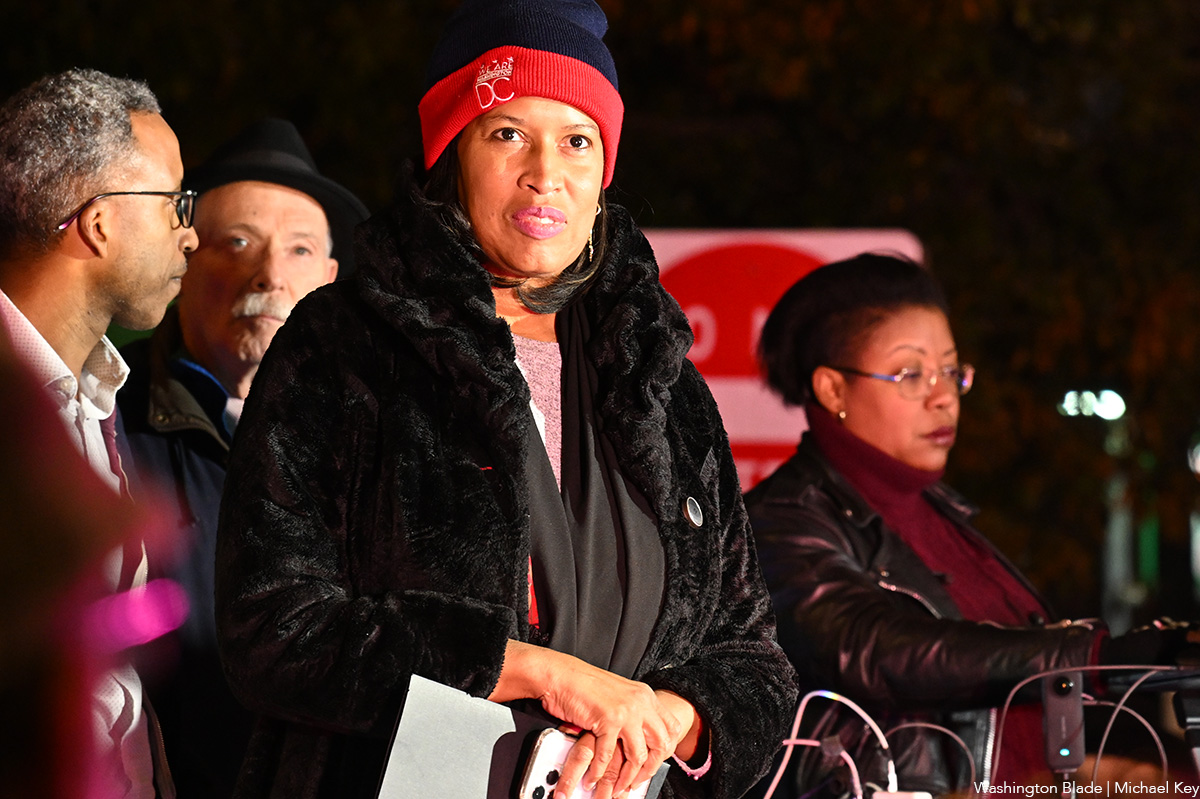
D.C. Mayor Muriel Bowser announced on Oct. 30 that she has arranged for at least $129 million in local D.C funds to be used to support as many as 141,000 D.C. residents in need who depend on the federal food assistance programs known as SNAP and WIC whose funding will be cut off beginning Nov. 1 due to the federal shutdown.
SNAP, which stands for the Supplemental Nutrition Assistance Program, and WIC, the Women, Infants, and Children Program, provide food related services for 10 million or more people in need nationwide.
Maryland Gov. Wes Moore, Virginia Gov. Glenn Youngkin, and Delaware Gov. Matt Meyer also announced similar plans to provide emergency state funds to replace the federal funds cut off beginning Nov. 1 for the two food programs.
Similar to Bowser, Moore and Youngkin said their replacement funds at this time would only last for the month of November. Each said they were hopeful that Congress would end the shutdown before the end of November.
“We know that SNAP and WIC play a critical role in keeping thousands of Washingtonians and millions of Americans put food on the table each month,” Bowser said in a statement. “We were hopeful it wouldn’t come to this – and we will need the federal government to reopen as soon as possible – but for right now, we’re moving forward to ensure we take care of D.C. residents in November,” she said.
The mayor’s statement says about 85,000 D.C. households, consisting of 141,000 individuals, receive SNAP support each month, with an average monthly allocation of $314. It says more than 12,500 city residents in 8,300 households benefit from the WIC program.
A spokesperson for the D.C. Mayor’s Office of LGBTQ Affairs couldn’t immediately be reached to determine whether the city has an estimated count of how many LGBTQ residents receive support from the SNAP and SIC programs.
-

 District of Columbia3 days ago
District of Columbia3 days ago‘Sandwich guy’ not guilty in assault case
-

 Sports3 days ago
Sports3 days agoGay speedskater racing toward a more inclusive future in sports
-

 Michigan5 days ago
Michigan5 days agoFBI thwarts Halloween terror plot targeting Mich. LGBTQ bars
-

 New Jersey4 days ago
New Jersey4 days agoBlue wave hits Northeast: Sherrill and Mamdani lead Democratic comeback

